| NO
|
FEATURED PICTURE
|
| 26
|

|
|
Photograph of the temple and gateway in Kashmiri style at Malot, Jhelum District, taken by Joseph David Beglar in the 1870s. Alexander Cunningham wrote in his report for the Archaeological Survey of India in 1872-3, "The only remains of any antiquity at Mallot are a temple and gateway in the Kashmirian style of architecture. They are built of a coarse sandstone of various shades of ochreous red and yellow, and many parts have suffered severely from the action of the weather, the surface having altogether crumbled away...The temple is a square of 18 feet inside, with a vestibule or entrance porch on the east towards the gateway. The gateway is...a massive building...divided into two rooms...On each side of these rooms to the north and south there are highly decorated niches for the reception of statues, similar to those in the portico of the temple. These niches are covered by trefoil arches which spring from flat pilasters. Each capital supports a statue of a lion under a half trefoil canopy...The roof is entirely gone; but judging from the square shape of the building, I conclude that it must have been pyramidal, outside with flat panelled ceilings of overlapping stones."
Photo credit: Talha
|
|
| 25
|

|
|
The Tulip Lawn is a popular and well-known garden locale, situated adjacent to the magnificent Tulip Riverside Hotel located at the bank of Jhelum River in Jhelum.
Photo credit: Talha
|
|
| 24
|

|
|
The National Museum of Pakistan in Karachi, Pakistan. At present there are a total of 11 Galleries in the Museum including an exquisite “Quran Gallery”, Indus Civilization artifacts, Gandhara Civilization Sculptures, Islamic Art, Miniature Paintings, Ancient Coins and Manuscripts documenting Pakistan's Political History.
Photo credit: Shahid1024
|
|
| 23
|
|
| 22
|
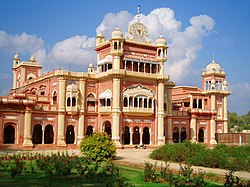
|
|
A beautiful view of Faiz Mahal in Khairpur, Sindh. Faiz Mahal was built in 1798 as the palace of the Talpur Dynasty in Khairpur Mirs. During the Talpur Rule Khairpur was considered as a Golden City famous for free education and healthcare, Tax freedoms and virtually no crime. It used to be cultural center famous for Ilm-e-Adab (Education and Literatures)and was provided with large parks, sports facilities and clubs.
Photo credit: Arsalan R. Kazi
|
|
| 21
|

|
|
A beautiful view of Islamabad from the Daman-e-Koh Park. It a popular viewing point in Islamabad. Its name is a conjunction of two words: Daman, which means center and Koh, which means hill. Daman-e-Koh therefore meaning center of the mountain. It can also be interpreted as hem of the mountain.
Photo credit: Finavon
|
|
| 20
|
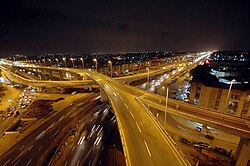
|
|
Nagan Interchange in Karachi, Sindh, Pakistan is one of the busiest interchanges of Karachi. The transport infrastructure is still in a development phase but has been given significant focus in the last two decades for improvement and modernization.
Photo credit: Suleman sajjad
|
|
| 19
|
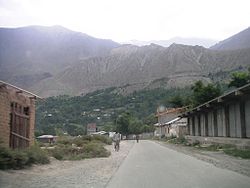
|
|
A beautiful view of Denin Valley, Chitral, Khyber Pakhtunkhwa, Pakistan
Photo credit: Rehmat Aziz Chitrali
|
|
| 18
|
|
| 17
|
|
| 16
|
|
| 15
|

|
|
The Margalla Hills are a series of hills located north of Islamabad, Pakistan. The Margallas are excellent for hiking purposes and cater to both the serious hiker and the less serious enthusiast. The forests of Margalla combine foliate trees with randomly occurring palm trees. The best season to hike are the mild winter months when there is less rain and the days are extremely pleasant.
Photo credit: Obaid747
|
|
| 14
|

|
|
The tomb of Shah Rukn-e-Alam (among the eminent Sufi saints from Multan, Pakistan) was built between 1320 and 1324, is an unmatched pre-Moghul masterpiece. The Mausoleum of Rukn-i-Alam could possibly be considered as the glory of Multan. From whichever side the city is approached, the most prominent thing that can be seen from miles all around is a huge dome. This dome is the Shrine of the saint. The tomb is located on the southwest side of the Fort premises. This elegant building is an octagon, 51 feet 9 inches in diameter internally, with walls 41 feet 4 inches high and 13 feet 3 inches thick, supported at the angles by sloping towers.
Photo credit: Zeeshan Javeed
|
|
| 13
|
|
| 12
|
|
| 11
|
|
| 10
|

|
|
The Noor Mahal is located in Bahawalpur, Punjab, Pakistan. It was built in 1872 like an Italian chateau on neoclassical lines, at a time when modernism had set in. There are various stories regarding its construction. According to one belief, Nawab Sadiq Muhammad Khan IV had the palace made for his wife. However, she was there for one night, only as she happened to see the adjoining graveyard from her balcony, and refused to spend another night there and so it remained unused during his reign.
Photo credit: Asdaqamin
|
|
| 9
|
|
| 8
|
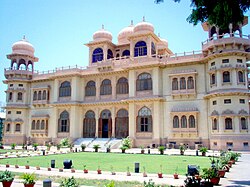
|
|
A magnificent view of Mohatta Palace in Karachi. It was built by Shivratan Chandraratan Mohatta, an ambitious self-made Hindu businessman from Marwar as his summer home in the late 1920s (1926 to be exact). The architect of the palace was Agha Ahmed Hussain. However, Mohatta could enjoy this building for only about two decades before political upheaval and the partition of the subcontinent forced him to leave Karachi.
Photo credit: Shizhao
|
|
| 7
|
|
| 6
|
|
| 5
|
|
| 4
|
|
| 3
|
|
| 2
|
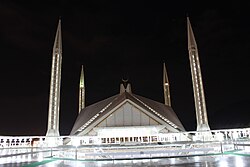
|
|
View of King Faisal Mosque at night in Islamabad. It is one of the largest mosques in the world. It is a state National Mosque. It is a popular masjid in the Islamic world, and is renowned for both its size and its architecture covering an area of 5,000 square meters with a capacity of 300,000 worshippers.
Photo credit: Ahmed Sajjad Zaidi
|
|
| 1
|
|